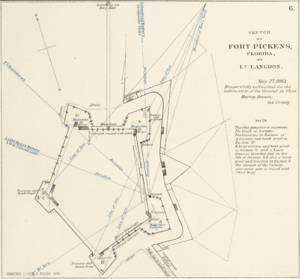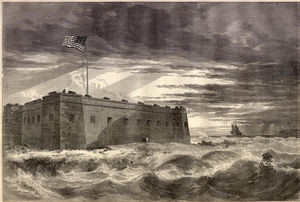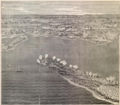Difference between revisions of "Fort Pickens"
(batteries) |
m (→Battery Worth) |
||
| Line 61: | Line 61: | ||
===Battery Worth=== | ===Battery Worth=== | ||
Completed in [[1899]], '''Battery Worth''' housed eight 12-inch mortars in two gun pits. Although the battery lost half its armament in [[1918]] in accordance with the War Department policy to reduce weaponry mounted in the nation's older emplacements, the other four mortars remained active until [[1942]]. The battery became essential for Army-Navy defense activities in the 1940s by housing the Fire Control Switchboard Room, Harbor Entrance Control Post and the Harbor Defense Command Post.<ref name="NPS" /> | Completed in [[1899]], '''Battery Worth''' housed eight 12-inch mortars in two gun pits. Although the battery lost half its armament in [[1918]] in accordance with the War Department policy to reduce weaponry mounted in the nation's older emplacements, the other four mortars remained active until [[1942]]. The battery became essential for Army-Navy defense activities in the 1940s by housing the Fire Control Switchboard Room, Harbor Entrance Control Post and the Harbor Defense Command Post.<ref name="NPS" /> | ||
| + | |||
| + | The Battery Worth area now hosts a picnic pavilion, restroom facilities, and outdoor shower. | ||
===Battery Payne=== | ===Battery Payne=== | ||
Revision as of 14:34, 11 June 2009
| Fort Pickens | |
|---|---|
| | |
| Santa Rosa Island at Pensacola Pass | |
| Type | Pentagonal fort |
| Built | 1829-1834 |
| In use | 1834-1947 |
| Controlled by | United States (1834-1947) |
| Battles | Battle of Santa Rosa Island |
| Events | Civil War |
| Present status | Decommissioned |
| Current owner | National Park Service |
Fort Pickens is a pentagonal historic United States military fort on Santa Rosa Island, at the entrance to Pensacola Bay. It is named after American Revolutionary War hero Andrew Pickens. The fort was completed in 1834 and remained in use in some form until 1947. Fort Pickens is currently part of the Gulf Islands National Seashore, and as such, is administered by the National Park Service.
Contents
Construction
French engineer Simon Bernard was appointed to design Fort Pickens. Construction on Fort Pickens lasted from 1829 to 1834, with 21.5 million bricks being used to build the fort. Much of the construction was done by slave labor.
Fort Pickens was the largest of a group of forts designed to fortify Pensacola's harbor. Fort Pickens supplemented Fort Barrancas, Fort McRee, and the Navy Yard. Located at the western tip of Santa Rosa Island, just offshore from the mainland, Pickens guarded the island and the entrance to the harbor. Its construction was supervised by Colonel William H. Chase of the U.S. Army Corps of Engineers. Ironically, during the Civil War some years later, Chase was later appointed by the State of Florida to command its troops and seize for the South the very fort he had built.
Civil War
By the time of the Civil War, Fort Pickens had not been regularly occupied since the Mexican–American War. However, Lieutenant Adam J. Slemmer, in charge of United States forces at Fort Barrancas, determined that Fort Pickens was more defensible than any of the other posts in the area.
His decision to abandon Fort Barrancas was hastened when, around midnight of January 8, 1861, his guards repelled a group of local men intending to take the fort. Some historians suggest that these were the first shots fired by United States forces in the Civil War. Shortly after this incident, Slemmer destroyed over 20,000 pounds of gunpowder at Fort McRee, spiked the guns at Barrancas, and evacuated about eighty troops to Fort Pickens. Despite repeated Confederate military threats to it, Fort Pickens remained in Union hands throughout the Civil War.
Late 19th century
The famous Apache Indian chief Geronimo arrived at Fort Pickens on October 25, 1886, where he was imprisoned along with several of his warriors until May 1887. Their families were held at Fort Marion.
During the late 1890s and early 1900s, new gun batteries were constructed at Fort Pickens. These batteries were part of a program initiated by the Endicott Board, a group headed by a mid-1880's Secretary of War, William Endicott. Instead of many guns located in a small area, the image most people have of a fort, the Endicott batteries are spread out over a wide area. This system used dispersement and concealment for protection from naval gunfire, which was more accurate and powerful than in the past. The use of the modern, powerful weapons eliminated the need for the concentration of guns that was common in the Third System fortifications. At Fort Pickens, one such battery was constructed physically inside the fort, while other similar concrete batteries were constructed to the east and west as separate facilities. The ruins of these later facilities are also included in the Gulf Islands National Seashore complex.
On June 20, 1899, a fire in Fort Picken's Bastion D reached the bastion's magazine, which contained 8,000 pounds of powder. The resulting explosion killed one soldier and obliterated Bastion D. The force of the explosion was so great that bricks from Bastion D's walls landed across the bay at Fort Barrancas, more than one and one-half miles away.[1] On January 30, 1903, five tons of condemned dynamite were detonated near the fort, about a mile away from the battery. The resulting explosion created a hole "large enough to hide a house" on the beach and was felt across Pensacola Bay in the city, cracking plaster and shattering windows.[2]
Hurricane Ivan
In September 2004, Hurricane Ivan battered the Gulf Islands National Seashore, causing extensive flooding, the destruction of a number of buildings, and a large number of felled trees. Despite the extensive damage, the actual fort "held its ground during the hurricane with only minor damage."[3]
Batteries
A number of weapons emplacements were constructed in and around Fort Pickens throughout the years.
Battery Pensacola
Battery Pensacola was constructed in 1898 on a portion of the parade ground within Fort Pickens. At the battery were mounted two 12-inch rifles on disappearing carriages capable of firing 1,070 lb. shells approximately 8 miles.[4]
Battery Van Swearingen
Battery Van Swearingen was activated on June 29, 1898. Two 4.7-inch guns were mounted on pedestal carriages.[4]
Batteries Cullum and Sevier
Battery Cullum and Battery Sevier, completed by 1898, housed four 10- inch rifles on disappearing carriages. Although these structures appear to be one large complex, they are two separate structures.[4]
Battery Worth
Completed in 1899, Battery Worth housed eight 12-inch mortars in two gun pits. Although the battery lost half its armament in 1918 in accordance with the War Department policy to reduce weaponry mounted in the nation's older emplacements, the other four mortars remained active until 1942. The battery became essential for Army-Navy defense activities in the 1940s by housing the Fire Control Switchboard Room, Harbor Entrance Control Post and the Harbor Defense Command Post.[4]
The Battery Worth area now hosts a picnic pavilion, restroom facilities, and outdoor shower.
Battery Payne
Completed in 1904, Battery Payne featured two 3-inch guns.[4]
Battery Trueman
Positioned on the western end of Santa Rosa Island, north of the harbor entrance, Battery Trueman was completed in 1905. The two 3-inch guns at Battery Trueman were relocated to Battery Cullum in 1943.[4]
Battery Cooper
Completed in 1906, Battery Cooper mounted two 6-inch guns on disappearing carriages. During World War I, the guns were removed for use on railway mounts in France. In 1937, four emplacements for 155mm guns were constructed around Battery Cooper and designated Battery GPF, remaining part of the Harbor Defense Project until the spring of 1945 when it was disarmed.[4]
Battery Langdon
Battery Langdon was completed in 1923 and mounted two 12-inch guns, en barbette. The battery is named in honor of Loomis L. Langdon, a man who was stationed at Fort Pickens on three occasions. In 1861 Langdon commanded a battery of 10-inch seacoast mortars at Fort Pickens; in 1874 he served as an artillery captain at the fort; and in 1885 he returned as a lieutenant colonel in charge of the 2nd U.S. Artillery. Langdon was in command when Geronimo was held in the fort.[4]
Battery #234
Plans for Battery #234 were developed in the early 1940s in response to the buildup to World War II. However, by the time Battery #234 was completed in 1943, the war's tide turned in favor of the Allies and the battery was never activated.[4]
Other images
References
- ↑ http://fcit.usf.edu/FLORIDA/photos/military/picken/picken.htm
- ↑ "Dynamite shook Pensacola." New York Times, January 31, 1903
- ↑ http://www.nps.gov/archive/guis/FLA/Hurricane%20Ivan/Hurricane.html
- ↑ 4.0 4.1 4.2 4.3 4.4 4.5 4.6 4.7 4.8 National Park Service - Gulf Islands National Seashore










